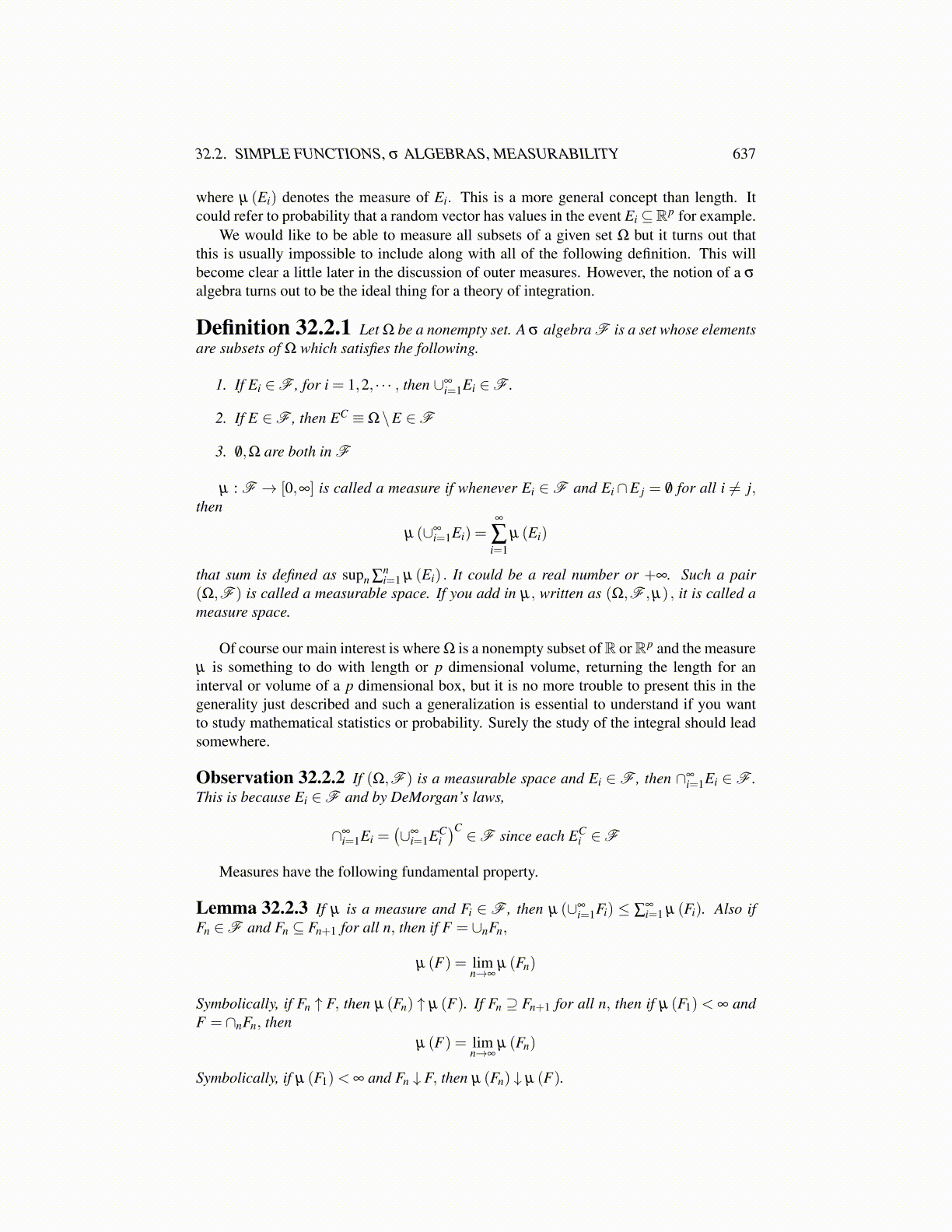
32.2. SIMPLE FUNCTIONS, σ ALGEBRAS, MEASURABILITY 637
Proof: Let f+ (ω) ≡ | f (ω)|+ f (ω)2 , f− (ω) ≡ | f (ω)|− f (ω)
2 . Thus f = f+ − f− and | f | =f++ f−. Also f = f+ when f ≥ 0 and f =− f− when f ≤ 0. Both f+, f− are measurablefunctions. Indeed, if a ≥ 0, f−1
+ ((a,∞)) = f−1 ((a,∞)) ∈ F . If a < 0 then f−1+ ((a,∞)) =
Ω. Similar considerations hold for f−. Now let s+n (ω) ↑ f+ (ω) ,s−n (ω) ↑ f− (ω) meaningthese are simple functions converging respectively to f+ and f− which are both increasingin n and nonnegative. Thus if sn (ω)≡ s+n (ω)−s−n (ω) , this converges to f+ (ω)− f− (ω) .Also
|sn (ω)|= s+n (ω)+ s−n (ω)≤ f+ (ω)+ f− (ω) = | f (ω)|
Proposition 32.2.11 Let fi : Ω → R be measurable, (Ω,F ) a measurable space, andlet g : Rp →R be continuous. If f (ω) =
(f1 (ω) · · · fp (ω)
)T, then g◦f is measur-
able.
Proof: From Corollary 32.2.10 above, there are
sin (ω) ,
simple functions limn→∞ sin (ω) = fi (ω) such that
∣∣sin (ω)
∣∣≤ | fi (ω)|. Let
sn (ω)≡(
s1n (ω) · · · sp
n (ω))T
thus, by continuity, g(sn (ω)) → g(f (ω)) for each ω. It remains to verify that g ◦ snis measurable. g−1 ((a,∞)) is an open subset of Rp and so by Theorem 32.1.5, it is acountable union of open boxes of the form Rk = ∏
pi=1
(uk
i ,vki). Thus
g◦s−1n ((a,∞)) = {ω : sn (ω) ∈ ∪∞
k=1Rk}= ∪ks−1n (Rk) = ∪∞
k=1 ∩pi=1
(si
n)−1(
uki ,v
ki
).
Now(si
n)−1 (uk
i ,vki)
consists of a finite union of measurable sets because sin has finitely
many values on measurable sets, and so it is measurable. Hence g ◦sn is measurable andso it follows from Corollary 32.2.7, g◦f is measurable because it is the limit of functionswhich are.
Note how this shows as a very special case that linear combinations of measurable realvalued functions are measurable because you could take g(x,y) ≡ ax+by and then if youhave two measurable functions f1, f2, it follows that a f1 +b f2 is measurable.
Definition 32.2.12 f : Ω → Rp is measurable means that each component func-tion is real valued and measurable.
Proposition 32.2.13 f : Ω → Rp is measurable where (Ω,F ) is a measurable spaceif and only if f−1 (open set) ∈ F .
Proof: If each component function is measurable, then
f−1
(p
∏k=1
(ak,bk)
)= ∩p
k=1 f−1k (ak,bk) ∈ F
By Theorem 32.1.5, every open set U is a countable union of open rectangles {Ri} sof−1 (U) = ∪if
−1 (Ri) ∈ F . Conversely, if f−1 (open set) is always measurable, then
f−1k (a,b) = f−1 (R×·· ·×(a,b)×·· ·×R)
is measurable so the component functions are measurable.